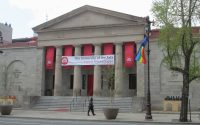Cameron Rowland Is Loaning an Acre of Land in South Carolina to Dia—But You Can’t Visit It
Cameron Rowland, an acclaimed artist known for conceptual projects involving bureaucratic structures, ready-made objects, and more, has found an institutional home—for now, at least—for one of their biggest projects to date.
In its most basic form, the work, Depreciation (2018), constitutes an acre of land on Edisto Island, South Carolina, that is now being placed on extended loan to the Dia Art Foundation, which is known for its deep holdings of Minimalist and Conceptualist art. But like many other Rowland pieces, this one unfolds a complex history dealing with structural racism, land ownership, and power.
Edisto Island is one of the many South Carolina landmasses that were set aside for freed enslaved people on January 16, 1865 as part of a policy more familiarly known as “40 acres and a mule.” Contemporary historians have regarded the policy as an effort to stave off the possibility of a revolt by the formerly enslaved.
Some 10,000 subsequently people settled on Edisto Island, but their situation did not last long. In 1866, after Abraham Lincoln was assassinated, Andrew Johnson revoked the policy more formally known as Field Order 15, leaving the door open for Confederate owners to repossess their land, including the site of the Maxcy Plantation, which occupied Rowland’s one-acre spot and some of the surrounding area.
Rowland’s piece of land, 8060 Maxie Road, was purchased by a similarly titled nonprofit. It has now been placed under a restrictive covenant, which allows for the control of how the land is used. According to their description for the work, 8060 Maxie Road is now valued at $0, and the public cannot visit it.
The project is in keeping with past works by Rowland, who is currently the subject of a show at the MMK Frankfurt in Germany. For one particularly memorable show at New York’s Artists Space in 2016, for example, they sourced furniture produced by Corcraft, a company that relies upon the labor of inmates to produce its goods, and re-presented them at Artists Space, along with related documentation.
Often, Rowland’s work is not available for acquisition by institutions, bucking the traditional mode by which art enters museum collections. Instead, they make their pieces available on loan, typically with stipulations that are disclosed to the general public. Depreciation is listed as being on “extended loan” to the Dia Art Foundation.
Though the land itself is not viewable, Dia promised to exhibit framed documents related to Depreciation at its Chelsea gallery.
“Dia’s stewardship of Depreciation continues our founding mission of forging sustained collaborations with artists to ensure the legacy of their work that, physically or conceptually, is often beyond the scope and scale of the conventional museum or gallery model,” director Jessica Morgan said in a statement. “While many of the other works that make up our constellation of locations and sites engage the physical encounter between the viewer, the work, and their surroundings, Depreciation instead probes the idea of site in an entirely different manner.”
For many years, Dia’s galleries have been filled predominantly by works by white men—the Richard Serras and Michael Heizers of the world. Morgan has stated that one of her goals is to change that, a project of which the loan of Depreciation appears to be a part.
Rowland will have a 2024 solo show with new work at Dia:Beacon. It will be organized by Dia curator Jordan Carter, who said in a statement with Matilde Guidelli-Guidi that Depreciation “critically shifts Land art’s terms of engagement and proposes new urgencies, stakes, and possibilities within the institution and the field.”



